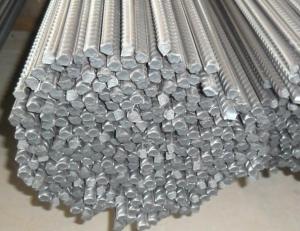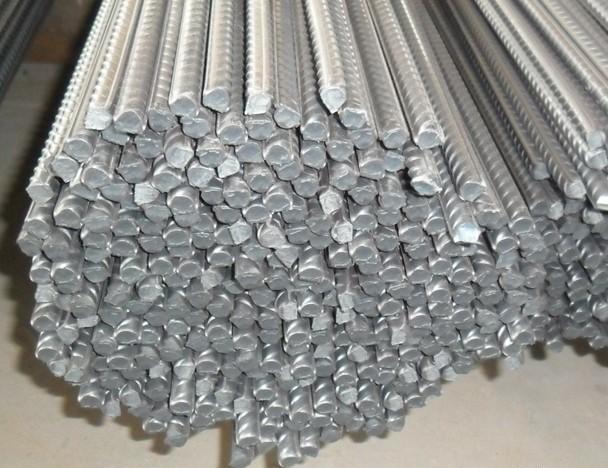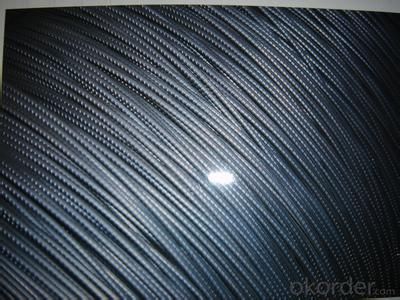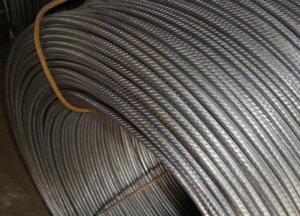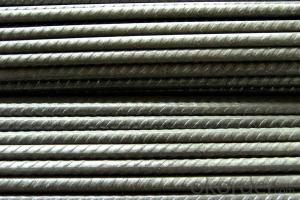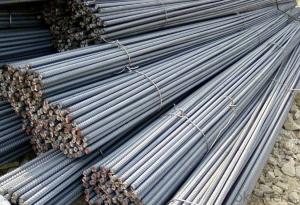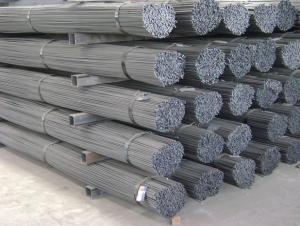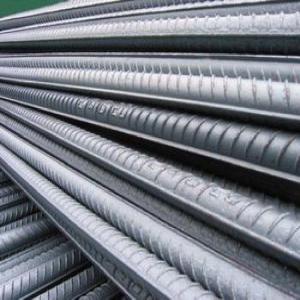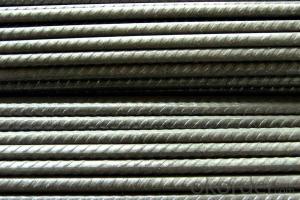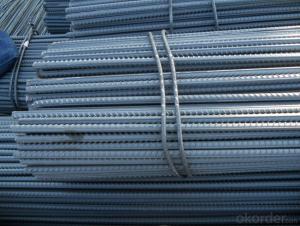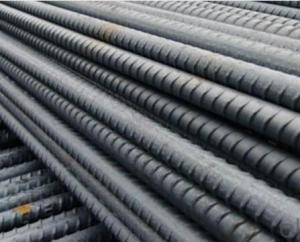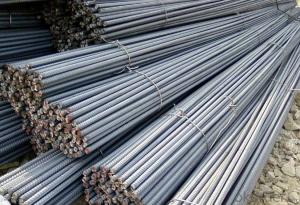Cold Rolled Steel Rebars with High Quality 6mm-50mm
- Loading Port:
- Tianjin
- Payment Terms:
- TT or LC
- Min Order Qty:
- 50 m.t.
- Supply Capability:
- 15000 m.t./month
OKorder Service Pledge
OKorder Financial Service
You Might Also Like
Specifications of Cold Rolled Steel Rebars with High Quality 6mm-50mm:
Name | Cold Rolled Steel Rebar | |
Diameter | 6mm,8mm,10mm,12mm,14mm,16mm,18mm,20mm, 22mm,25mm,28mm,32mm,36mm,40mm,50mm | |
Length | 6M, 9M,12M or as required | |
Price | Keep lower operating costs so as to offer competitive price for our clients | |
Label | to be specified by customer, generally, each bundle has 1-2 labels | |
Application | Building, construction | |
Invoicing | Actual or Theoretical Weight Basis as buyer’s request. | |
Theoretical weight and section area of each diameter of Cold Rolled Steel Rebars with High Quality 6mm-50mm as below for your information :
Diameter(mm) | Section area (mm²) | Mass(kg/m) | Weight of 12m (kg) | Pcs/ton |
6 | 28.27 | 0.222 | 2.664 | 375.38 |
8 | 50.27 | 0.395 | 4.74 | 210.97 |
10 | 78.54 | 0.617 | 7.404 | 135.06 |
12 | 113.1 | 0.888 | 10.656 | 93.84 |
14 | 153.9 | 1.21 | 14.52 | 68.87 |
16 | 201.1 | 1.58 | 18.96 | 52.74 |
18 | 254.5 | 2.00 | 24 | 41.67 |
20 | 314.2 | 2.47 | 29.64 | 33.74 |
22 | 380.1 | 2.98 | 35.76 | 27.96 |
25 | 490.9 | 3.85 | 46.2 | 21.65 |
28 | 615.8 | 4.83 | 57.96 | 17.25 |
32 | 804.2 | 6.31 | 75.72 | 13.21 |
36 | 1018 | 7.99 | 98.88 | 10.43 |
40 | 1257 | 9.87 | 118.44 | 8.44 |
50 | 1964 | 15.42 | 185.04 | 5.40 |
Packaging & Delivery of Cold Rolled Steel Rebars with High Quality 6mm-50mm:
Packaging Detail: products are packed in bundle and then shipped by container or bulk vessel, deformed bar is usually naked strapping delivery, when storing, please pay attention to moisture proof. The performance of rust will produce adverse effect.
Each bundle weight: 2-3MT, or as required
Payment terms: TT payment in advance or Irrevocable LC at sight.
Trade terms :FOB, CFR, CIF
Delivery Detail: within 45 days after received advanced payment or LC.
FAQ:
Q1: Why buy Materials & Equipment from OKorder.com?
A1: All products offered byOKorder.com are carefully selected from China's most reliable manufacturing enterprises. Through its ISO certifications, OKorder.com adheres to the highest standards and a commitment to supply chain safety and customer satisfaction.
Q2: How do we guarantee the quality of our products?
A2: We have established an advanced quality management system which conducts strict quality tests at every step, from raw materials to the final product. At the same time, we provide extensive follow-up service assurances as required.
Q3: How soon can we receive the product after purchase?
A3: Within three days of placing an order, we will arrange production. The shipping date is dependent upon the quatity, how many sizes you want and the plan of production, but is typically 1 month to 2 month days from the beginning of production.
Images of Cold Rolled Steel Rebars with High Quality 6mm-50mm:
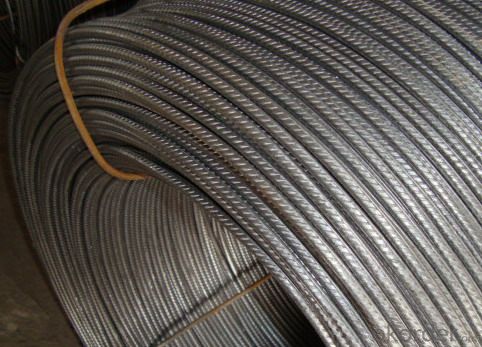
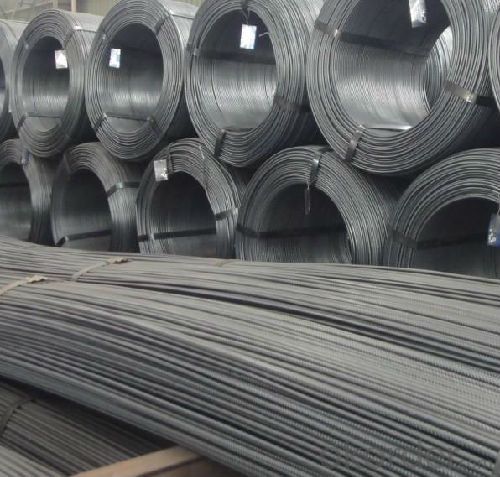
- Q: How are steel rebars protected against galvanic corrosion in concrete?
- Steel rebars are protected against galvanic corrosion in concrete through the use of various methods such as applying protective coatings, using corrosion inhibitors, and ensuring proper concrete cover. These measures prevent the contact between the rebar and the aggressive elements in the concrete, thereby reducing the risk of galvanic corrosion.
- Q: How do steel rebars affect the overall longevity of a structure?
- Steel rebars, also known as reinforcement bars, play a crucial role in enhancing the overall longevity of a structure. By providing strength and durability, rebars reinforce the concrete, making it more resistant to cracking and structural failure. This reinforcement ensures that the structure can withstand various external forces, such as extreme weather conditions, seismic activity, and heavy loads. Consequently, the use of steel rebars significantly extends the lifespan of a structure, ensuring its long-term stability and safety.
- Q: Can steel rebars be used in residential swimming pool construction?
- Yes, steel rebars can be used in residential swimming pool construction. Steel rebars provide structural reinforcement to the pool walls and floor, ensuring stability and durability.
- Q: How are steel rebars specified in construction drawings?
- In construction drawings, steel rebars are specified using a combination of symbols, labels, and dimensions. These specifications provide detailed information about the size, shape, and placement of the rebars within the concrete structure. The specifications for steel rebars typically include the following information: 1. Rebar Size: The diameter of the rebar is specified using a numerical value, such as 8, 10, 12, etc., which indicates the bar size in millimeters or inches. 2. Rebar Shape: The shape of the rebar can be specified using symbols or abbreviations, such as "D" for deformed or "SD" for smooth and deformed. 3. Rebar Spacing: The spacing between rebars is typically specified using a numerical value, such as 150, 200, or 300, which indicates the distance between the centerlines of adjacent rebars in millimeters or inches. 4. Rebar Bending: If rebars need to be bent to a specific shape, the bending details are often included in the construction drawings. This includes the angle and radius of the bend, as well as the location at which the bending is required. 5. Rebar Placement: Construction drawings typically include plans, sections, and elevations that show the precise location and arrangement of the rebars within the concrete structure. These drawings may include details such as the number of rebars, their orientation, and their position relative to other elements of the structure. 6. Rebar Schedule: A rebar schedule is often provided in construction drawings, which summarizes all the specifications for each rebar element in a tabular format. This includes information such as the rebar mark, size, length, weight, and any special instructions. Overall, the specifications for steel rebars in construction drawings ensure that the rebars are correctly fabricated, installed, and integrated into the concrete structure, meeting the design requirements and ensuring the structural integrity and safety of the building.
- Q: Can steel rebars be used in historical building preservation?
- Yes, steel rebars can be used in historical building preservation. Steel rebars are commonly used to reinforce and strengthen structures, including historical buildings. They provide structural support and help maintain the integrity of the building while preserving its historical significance. However, it is important to ensure that the use of steel rebars is done carefully and in accordance with preservation guidelines to minimize any potential damage or alteration to the historical fabric of the building.
- Q: What grade of reinforcement is used for cast-in-place floorslab?
- Now the more commonly used high-rise buildings are cast-in-place floorslab.The floor slab, of course, separates the floor and bears and transmits the floor load. At the same time, heat insulation, sound insulation, waterproof and so on.
- Q: What is the process of cutting steel rebars on-site?
- The process of cutting steel rebars on-site involves several steps to ensure accurate and precise cuts. Here is a general outline of the process: 1. Measurement and Marking: First, the length required for the steel rebar is measured using a tape measure or other measuring tools. Once the desired length is determined, it is marked on the rebar using a chalk line or a permanent marker. 2. Safety Measures: Before proceeding with the cutting process, it is crucial to ensure safety. Workers should wear appropriate personal protective equipment (PPE), including gloves, safety glasses, and steel-toe boots. Additionally, the work area should be clear of any obstructions or hazards. 3. Set Up the Cutting Tools: There are various tools available for cutting steel rebars on-site, such as an angle grinder with a cutting disc, a reciprocating saw with a metal-cutting blade, or a rebar cutter. The chosen tool should be set up and secured according to the manufacturer's instructions. 4. Cutting the Rebar: Once the cutting tool is ready, the marked section of the rebar is positioned securely on a stable surface. The cutting tool is then carefully guided along the marked line, applying consistent pressure to achieve a clean and precise cut. It is essential to maintain control of the cutting tool throughout the process to avoid any accidents. 5. Inspecting the Cut: After the cut is made, it is important to inspect the quality of the cut. The cut end should be smooth and free from any burrs or rough edges. If necessary, a file or a grinding tool can be used to smooth out any imperfections. 6. Handling and Disposing: Once the steel rebar is cut to the desired length, it can be safely handled and used for its intended purpose. Any leftover pieces or scraps should be appropriately disposed of, following local regulations for metal waste disposal. It is crucial to note that the exact process and tools used for cutting steel rebars on-site may vary depending on the specific requirements, available equipment, and safety protocols of the construction site. It is always recommended to follow the manufacturer's instructions and consult with professionals when carrying out such tasks.
- Q: How do steel rebars improve the load-carrying capacity of concrete?
- Steel rebars improve the load-carrying capacity of concrete by providing additional tensile strength. When concrete is subjected to heavy loads or forces, it tends to crack under tension. The inclusion of steel rebars within the concrete helps to counteract this weakness by absorbing the tensile forces and distributing them throughout the structure. This reinforcement enhances the overall durability and structural integrity of the concrete, allowing it to bear heavier loads without failing.
- Q: What is the role of steel rebars in preventing concrete segregation?
- Steel rebars play a crucial role in preventing concrete segregation by providing structural support and reinforcement to the concrete. When concrete is poured, it is in a liquid state and has a tendency to separate or segregate, with heavier aggregates settling at the bottom and lighter materials rising to the top. This can lead to an inconsistent and weak concrete structure. By placing steel rebars within the concrete, they act as a framework or skeleton, holding the concrete together and preventing segregation. The rebars help distribute the weight and forces evenly, ensuring that the concrete mixture remains well-mixed and homogeneous throughout. Additionally, steel rebars also enhance the tensile strength of the concrete. While concrete is strong in compression, it is relatively weak in tension. The rebars absorb the tensile forces, preventing cracks and fractures from forming in the concrete. This reinforcement allows the concrete structure to withstand external loads, such as the weight of a building or the force of an earthquake, without breaking apart. In summary, the role of steel rebars in preventing concrete segregation is twofold - they provide structural support and reinforcement, ensuring a homogeneous mixture and enhancing the overall strength and durability of the concrete structure.
- Q: How do steel rebars affect the cost of a construction project?
- Steel rebars can significantly affect the cost of a construction project because they are a crucial component in reinforced concrete structures. The cost of steel rebars depends on their quantity, grade, and size, and it can greatly impact the overall project budget. Additionally, the transportation and installation costs associated with steel rebars should also be taken into account. Therefore, careful planning and consideration of the type and amount of steel rebars required are essential to manage and optimize the project's cost.
Send your message to us
Cold Rolled Steel Rebars with High Quality 6mm-50mm
- Loading Port:
- Tianjin
- Payment Terms:
- TT or LC
- Min Order Qty:
- 50 m.t.
- Supply Capability:
- 15000 m.t./month
OKorder Service Pledge
OKorder Financial Service
Similar products
Hot products
Hot Searches
Related keywords
